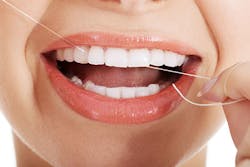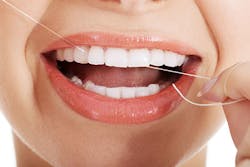The Flossing Files
BY EILEEN MORRISSEY, RDH, MS
Last week a new patient complimented me at the end of her appointment about how gently I had flossed her teeth. Specifically, she remarked that she appreciated my not "snapping the dental floss into her gums like her last two hygienists." I thought flossing might be a timely topic for today's column.
It's difficult to understand why a clinician would not choose the gentle approach. Is it the time factor? It does take longer to go around the mouth slowly, easing the floss through the tight part of the contact and gently bringing it into the base of the sulcus, but it is such an opportunity to provide a learning model for patients.
-----------------------------------------------
Other articles by Morrissey
-----------------------------------------------
This column pertains only to hygienists who floss their patients' teeth. I understand that some skip this procedure. It's an easy way to save time with the rationale that interproximal debridement has already happened via instrumentation. Personally, I was trained to always include flossing as part of my protocol, and it is engrained in me. I will say that patients take notice. For clients who do not floss regularly, many want the task completed at their recare visit for that very reason.
Your patient reports that she is a flossing queen, making this discipline a daily part of her routine. Yet, as you probe her tissues, you find copious amounts of plaque biofilm with corresponding bleeding and inflammation. How can this be so? Most of the time it's due to a person's technique.
What I like to tell patients is, "Watch me and compare your approach with mine as I floss your teeth." I remind them that it's easy to feel triumphant when a piece of steak comes flying out; however, the sticky bacteria will remain behind unless the floss is used scraper-style to remove it. The old "in-out" routine of their ritual is quick and gratifying to those who floss regularly, but it is not doing the task effectively.
I reiterate, "If you're going to go to this effort each day, make sure you're doing it right..." For the record, it's not always easy to be frank with people who think they have a stellar home-care routine, but the evidence is in the amount of debris present and the subsequent bleeding. And how many patients think that bleeding is due to pressing the floss too hard? It's our responsibility to remind them that bleeding can be a sign of inflammation. We should not see inflammation or large amounts of debris in patients who floss every day.
More evidence of flossing mishaps that may leap out upon examination is tiny interproximal clefts in a mouth that is typically immaculate. Note that these patients are also usually abraded due to overzealous tooth brushing. Frequently upon questioning their technique, I will recognize that a person is bearing down with the floss into their gum tissues so heavily that they leave an imprint behind. I'm often able to show them precisely how the floss fits into the clefts they've created. Turns out that these very patients think that we clinicians are not flossing them effectively because we're not "pressing hard enough." So again, it becomes very important to educate patients.
It's also wise to inform patients that "floss cuts" can easily happen when using the flossers that are so popular with folks who gave up on string floss. I dislike the use of these in my own heavily restored mouth.
Be happy with your patients who floss daily. I knew a fanatical RDH who flossed her teeth twice a day, so once was never enough for her patients. What? And don't you think water flossers for orthodontic patients are one of the coolest tools we can recommend for teenagers? It appeals to their love of gadgetry, and it is so much easier than threading through each contact. Ah, the majestic power of lavage!
For those of us who floss our patients' teeth, it is imperative that we do not overlook fixed bridgework. So very often patients routinely floss everything except that which requires a threader, and it is a task they want us to perform.
Then there are my favorite soft picks and other such interproximal devices, because after all, flossing is not the be-all and end-all. But that's another column... Onward we go; it is in our heart's core! RDH
EILEEN MORRISSEY, RDH, MS, is a practicing clinician, speaker, and writer. She is an adjunct dental hygiene faculty member at Burlington County College. Eileen offers CE forums to doctors, hygienists, and their teams. Reach her at [email protected] or 609-259-8008. Visit her website at www.eileenmorrissey.com.

